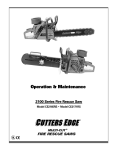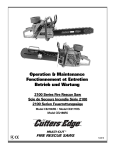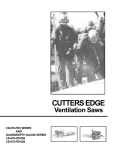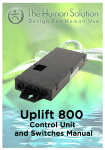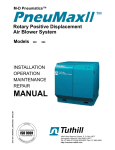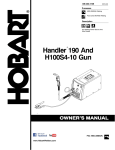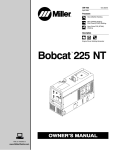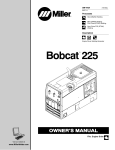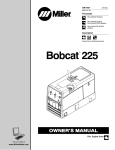Download Cutters Edge 2000 Series Specifications
Transcript
CE 2071 RS-20" CE 2065 RS/D6 CUTTERS EDGE ® FIRE RESCUE SAWS Operation & Maintenance 2000 SERIES ... CE2065RS AND CE2071 RS AND GUARD DEPTH GAUGE® SERIES CE2065 RS/D6... D8 CE2071 RS/D6... D8 CUTTERS EDGEÆ FIRE RESCUE SAW BULLET® CHAIN GUARD/DEPTH GAUGE® Copyright ©1998 Edge Industries, Inc. All rights reserved. No part of this manual may be reproduced or transmitted in any form or by any means, electronic, mechanical, photocopying, recording, or otherwise, without the prior written permission of the publisher. For information, contact Edge Industries, Inc. Notice of Liability: The information in this manual is distributed on an "As Is" basis, without warranty. Edge Industries, Inc. shall have no liability to any person or entity with respect to any liability, loss, or damage caused or alleged to be caused directly or indirectly by the instructions contained in this manual. CUTTERS EDGE FIRE RESCUE SAWS Operation & Maintenance Cutters Edge P.O. Box 846 3855 23rd Street Baker City, Oregon 97814 2 / CUTTERS EDGE FIRE RESCUE SAWS CUTTERS EDGE® FIRE RESCUE SAWS Operation & Maintenance Table of Contents INTRODUCTION ............................................................................... 3 KICKBACK WARNING ..................................................................... 4 DESCRIPTION .................................................................................. 5 Part One SET-UP .........................................................................................6-14 D6 & D8 GUARD / DEPTH GAUGE Part Two OPERATION ............................................................................... 15-18 Part Three MAINTENANCE ......................................................................... 19-21 SPECIFICATIONS ........................................................................... 22 WARRANTY .....................................................................................23 ORDER FORMS .............................................................................. 24 OPERATION & MAINTENANCE / 3 CUTTERS EDGE® FIRE RESCUE SAWS Operation & Maintenance Manual Edge Industries, Inc. VENTILATION: The purpose of ventilation is the establishment of a safer interior environment through planned and systematic removal of heat, smoke, and toxic gases and their replacement with fresh air. It is an offensive technique that, when accomplished early and effectively, can speed tactical operations. As fire develops within a structure, several conditions result. First, the temperature and toxicity of the atmosphere increase rapidly. Then radiated and convected heat result in flashover and the subsequent rapid spread of fire throughout the structure. Without ventilation, the fire will develop a super-heated, oxygen-deficient, and fuel-rich environment ripe for backdraft. Firefighters can minimize these conditions with proper ventilation techniques and proper tools. Knowledge, training and Cutters Edge Fire Rescue Saws are the proper tools. Cutters Edge Fire Rescue Saws are designed and built exclusively for use by TRAINED FIREFIGHTERS. Although Cutters Edge Fire Rescue Saws are essentially modified chain saws, their use and applications differ substantially. This manual is provided to assist you in learning the safe and proper set-up, operation and maintenance of your new Cutters Edge Fire Rescue Saw. However, you should not attempt to use this tool without knowledge of the safe and proper application of power saws in fighting fires. Cutters Edge recommends that you view the video edition of this training manual that further ill ustrates these steps and techniques. This manual is in no way intended to replace the chainsaw manuals, rather it should be used as a supplemental manual dealing with the specific applications of this specialized tool. Nor are the guidelines for operational procedures described herein intended to contradict the standard operating procedures (SOP) of your individual fire department. For more information about the principles and techniques of ventilation, we recommend the book "FIRE RESCUE METHODS AND TECHNIQUES", by Los Angeles City Fire Department Battalion Chief John Mittendorf. There are order forms for both the video and Chief Mittendorf's book at the back of this manual. RESCUE: With the introduction of the BULLET® CHAIN, applications for your CUTTERS EDGE® FIRE RESCUE SAW have increased dramatically! Ventilation, Forcible Entry, Storm Damage, Rescue, Crash Rescue (Aircraft & Automobile) and conventional chain saw and rotary saw applications are some of the many operations your saw can be used in. While chain wear and damage may be accelerated when cutting materials other than wood. Your BULLET® CHAIN equipped saw is capable of cutting most building materials including nails, sheet metal and some lightweight concretes. It i s capable of cutting automotive sheet metal, automotive glass, plastics, fiberglass and many composite materials. It can cut aircraft skin, cockpit and aircraft windows and even some aircraft structural materials.* There are of course limitations, but your CUTTERS EDGE FIRE RESCUE SAW with BULLET® CHAIN will cut a wide variety of materials under the most severe fireground and rescue scene conditions. This manual will take you through each step of assembling the saw when you receive it, how to properly operate the saw, and how to clean and maintain the saw after use. Before attempting to assemble or use your saw, we strongly suggest that you view the optional video completely and read the manual completely. Then carefully follow the instructions in this manual as you proceed to prepare your Cutters Edge Fire Rescue Saw for use. WARNING Please take note of the warnings in this manual and the warning labels attached to various parts of the saw and its accessories. Read these warnings and heed their advice. Failure to do so could result in injury to you and/or damage to the saw. Any warranties provided by the manufacturer will not cover abuse, neglect or mishandling of the saw. • When materials other than wood are cut, increased wear and damage should be anticipated. The possibility of chain breakage also increases. All materials listed have been successfully cut under controlled conditions and during actual fireground and rescue incidents. However, quantlty, composition of specific materials, operator experience, existing conditions, and unknown factors can adversely affect the outcome. 4 / CUTTERS EDGE FIRE RESCUE SAWS WARNING Beware of kickback! There are two types of kickback that can be encountered with the improper use of a chainsaw or the Cutters Edge Fire Rescue Saw. Both types are the result of an equal and opposite reaction that occurs when the chain i s suddenly stopped. This kickback movement is so fast that the operator cannot react quickly enough to avoid serious injury. ROTATIONAL KICKBACK is the violent reaction which occurs when the chain at the upper section of the nose is suddenly stopped, thereby dangerously driving the bar nose in an upward arc towards the operator. LINEAR KICKBACK i s a push reaction, which can occur with the saw blade buried in the cut when the cut closes, pinching the chain along the top rails of the bar. KICKBACK MAY OCCUR WHEN: The upper section of the nose or tip of the guide bar touches an object. The wood closes in and pinches the saw chain in the cut. Tip contact in some cases may cause a lightning-fast reverse reaction, kicking the guide bar up and back towards the operator. Pinching the chain along the top of the guide bar may push the saw rapidly back towards the operator. Either of these reactions may cause you to lose control of the saw, which could result in serious personal injury. Cutters Edge builds several safety devices into their saws, but you should not rely exclusively upon these safety devices. As a Fire Rescue saw user, you should take several steps to keep your cutting jobs free from accident or injury: 1) With a basic understanding of kickback, you can reduce or eliminate the element of surprise. Sudden surprise contributes to accidents. 2) Keep a good firm grip on the saw with both hands when the engine is running. Use a firm grip with thumbs and fingers encircling the chainsaw handles. A firm grip will help you reduce kickback and maintain control of the saw. Don't let go. 3) Make sure that the area in which you are cutting is free from obstructions. Do not let the kickback zone of the guide bar contact any obstructions while you are operating the saw. 4) For ventilation and rescue cutting, always cut at full RPMs. 5) Do not overreach or cut above shoulder height 6) Follow manufacturer's sharpening and maintenance instructions for the BULLET® CHAIN. 7) Only use replacement bars and chains specified by the manufacturer or the equivalent. OPERATION & MAINTENANCE / 5 CUTTERS EDGE FIRE RESCUE SAW Cutters Edge Fire Rescue Saws are shipped fully assembled. The 12", 16" and 20" RS Models come with a protective scabbard covering the BULLET® CHAIN. The GUARD/DEPTH GAUGE® on the D6 and D8 Models covers the BULLET® CHAIN so a scabbard is not included. Familiarize yourself with the saw and its components. 1. Chain Brake Handle 2. Oil Tank Cap 3. Starter Handle 4. Fuel Tank Cap 5. Throttle Trigger 6. Throttle Safety Lock 7. Pre-Filter 8. Filter Element 9. On/Off... Momentary Contact Switch 10. Scrench Tool 11. Scrench Tool Holder 12. Guard Deflector 13. Choke Control 14. Full Wrap Handle 14 6 / CUTTERS EDGE FIRE RESCUE SAWS Part One Set-Up This section will cover assembly of the saw and preparation for operation. All necessary tools and equipment have been included with your saw. 3. 1. 2. THE CHAIN BRAKE The chain brake is designed to stop the rotation of the chain in less than one-twentieth of a second. If kickback should occur, the violent reverse action will drive the chain brake handle back into the operator's top hand, engaging the chain brake and stopping movement of the chain. We utilize a sealed inertia chain brake which works on the same principle as an auto seat belt. The chain brake has three positions3. l 1. I 2. Fig. 3. Back position, to disengage chain brake. l To disengage the chain brake, pull the chain brake handle back completely to the saw's top handle (Fig. 3). It is important that the chain brake handle comes to full contact with the saw's handle. Any obstructions, such as your hand, will prevent disengagement of the chain brake. Once you have pulled the chain brake handle back completely, let go and it will snap back to the center or operating position. Fig. 1. Center - Neutral position, chain brake disengaged. THE CLUTCH COVER During operation, the brake is in the neutral, or center position (Fig. 1). This allows the chain to turn freely. Place the power head on your work surface, use the scrench tool to loosen the two clutch cover nuts (Fig. 4). Fig. 2. Forward position, chain brake engaged. When engaged, the chain brake handle is in the fully forward position (Fig. 2). At this point, the chain will not turn. CAUTION If the saw is run with the chain brake engaged - the clutch, oil pump, and chain brake will be damaged. Fig. 4. Clutch cover nuts. Remove the clutch cover. Now you can visually inspect the chain brake to see how it operates. When engaged, the chain brake band grabs the spinning clutch drum and immediately stops it. OPERATION & MAINTENANCE / 7 THE BAR PLATES THE CHAIN COMPONENTS Remove the outer bar plate. Note that the two bar plates are similar (Fig. 5) but that the inner bar plate is smaller and has an additional slot that allows oil to reach the chain. Before installing the chain, take a moment to become famili ar with the components of the BULLET CHAIN (Fig. 7). Top plate Carbide Tip Gullet } Side plate Depth gauge bullet Rivet hole Toe Heel Left hand cutter Preset tie strap Fig. 5. Inner tear plate, with oil slot WARNING It is imperative that the inner plate with the oil slot is installed properly or the flow of bar oil will be blocked and damage to the saw and chain will occur. INSTALLING THE BAR AND CHAIN Next, install the bar by first adjusting the chain tensioning screw fully back (using the scrench tool, turn the tensioning screw counter clockwise to move the tensioner back toward the clutch drum) (Fig. 6). Slide the guide bar onto the 2 bar studs, aligning the tensioner with the adjusting hole in the bar. TENSIONER Fig. 6. Chain tensioning screw Fig. 7. Components of the chain INSTALLATION OF THE CHAIN To install the chain, first align the chain so that the cutters are pointing toward the tip of the bar as they lay on the top of the bar. Slip the chain onto the clutch sprocket rim (Fig. 8). Then slip the chain into the groove of the guide bar, again verifying that the top cutters point toward the tip of the bar. I TENSIONING SCREW Fig. 8. Insert the chain into the drive sprocket. 8 / CUTTERS EDGE FIRE RESCUE SAWS Pull the chain around the bar to be sure the drive links are properly seated in the drive sprocket. clearing the rail". (Fig. 10) when you let go, the chain should "snap back into place." Now replace the outer bar plate. Replace the clutch cover, tightening the clutch cover nuts only finger tight. SECURING THE BAR & CHAIN Wearing gloves or with a shop rag protecting your hand, pull up on the tip of the bar. While holding up the bar tip, tighten the chain tension adjustment screw by turning it clockwise. While still holding up the bar tip, tighten the clutch cover nuts (Fig. 9). Holding up the tip of the bar takes out any slack between the bar mounting slot and the two mounting studs. This will eliminate any upward movement of the bar when cutting pressure is applied at the bottom of the bar. Any such upward movement of the bar would cause the chain to loosen. Fig. 10.Sprocket-tip tension. Slide the chain completely around the bar once or twice to check that it moves smoothly. FILLING THE TANKS WARNING DO NOT USE GASOHOL OR ALCOHOL BLENDED FUELS. I MPORTANT Fig. 9.Tightening the clutch cover nuts. Please note that each time you fill up or top off the fuel tank, always top off the bar and chain oil tank. The fuel tank and the bar and chain oil tank are sized so that the saw will always run out of fuel before it runs out of bar and chain oil, eliminating the possibility of running the chain dry. CHAIN TENSION Proper chain tension is a key factor in reducing carbide breakage and increasing guide bar life. Proper chain tension has the chain as tight as possible without restricting chain movement. At proper tension, the chain should move along the bar freely. You should feel only the resistance of the sprocket and clutch drum turning. If the chain does not move smoothly i.e., catches or requires excessive force to move, it is too tight. At proper tension, the chain is in full contact with the bar along the bottom rails, there is no "sag". At the midpoint along the bottom rails, when pulling down on the chain, you should be able to pull the chain away from the rails - to the distance where point of the drive link is "just IMPORTANT Proper chain tension setting requires a fully lubricated "broken-in" chain. See "Running-in the chain (Page 12). Lay the saw on its side and remove the fuel tank cap. Fill with a fresh mixture of high octane leaded or unleaded gasoline and Cutters Edge Synthetic 2-Cycle Oil or a high quality two-cycle oil. Replace the cap. NOTE: Mix Cutters Edge Synthetic 2-Cycle Oil at 100:1 and petroleum-based 2-cycle oils at 50:1 Cutters Edge 2-Cycle Oil has been developed for use in all 2-cycle engines used in the fire service. Next remove the bar and chain oil tank cap and fill the tank with bar and chain oil. Replace the cap. You do not need special detergent oils; as the chain produces high enough temperatures to prevent the buildup of tars on the chain. OPERATION & MAINTENANCE / 9 STARTING THE SAW WARNING Do not mix the bar and chain oil with diesel or kerosene as this actually reduces its lubricating ability and does not reduce tar buildup. To start the saw, place it on the ground. If you intend to runi n the chain at this point, you should perform these steps outdoors or in a well-ventilated area. NOTE: We recommend the use of Cutters Edge Bar & Chain Oil for its excellent lubricating and anti-sling properties. This oil has been developed to provide high flash and fire points for optimum performance during harsh fire-ground applications, with high flow properties for use even in extreme cold temperatures. This anti-rust, anti-wear formula is recommended for use on all Fire Rescue saws and other conventional chainsaw. THE FILTERS Do not start the saw with the chain brake engaged. Be sure the chain brake is disengaged by pulling back the chain brake handle until it contacts the front of the full wrap handle. (See page 8.) Grip the top handle firmly and step on the outer edge of the back handle (Fig. 12). The filter element is coated at the factory and needs no oil prior to this first use. THE MOMENTARY CONTACT SWITCH The saw is now ready to start. Before starting the saw, you should know how to stop it. The Cutters Edge Fire Rescue Saw is equipped with a momentary contact switch that is always in the "on" position (Fig. 11). To stop the saw, push the momentary contact switch to the right. This kills the saw. When released, the switch will snap back to the "on" position automatically. Fig. 12. Proper starting position. COLD START Pull out the choke knob." This automatically locks the throttle trigger and the carburetor into their optimum positions for starting. If you do not touch the throttle during starting, there is no possibility of flooding. 2. Grasp the starter handle and pull sharply upward a few ti mes until the engine catches. 3. Push the choke in. 4. Pull the handle again. The engine will start. Fig. 11. Momentary contact switch. I MPORTANT Before starting the saw, it is important to note that you should not run the saw at full throttle until after breaking in the engine, which will be the procedure following running-in the chain. 5. Quickly squeeze and release the trigger to set the idle. WARM START (engine still warm from previous use) 1. Pull starter rope until saw starts. *We recommend storing the saw with the choke knob pulled out. 10 /CUTTERS EDGE FIRE RESCUE SAWS NOTE Note that you must depress the safety lock on top of the handle to be able to pull the trigger (Fig. 14). The trigger cannot be pulled without depressing this safety lock. Once it is cool enough to handle, readjust the chain to the proper tension. NOTE Repeat this entire chain adjusting procedure once more. Running-in the chain will remove approximately 75% of chain stretch. However, under normal use the chain will continue to stretch throughout its life. Re-check the chain tension during prolonged use and after each use. BREAKING IN THE ENGINE WARNING Fig. 13. Throttle lock. Proper breaking-in of the engine is a crucial step in the set-up of your saw. This procedure allows the cylinder to coat with oil and seat the piston ring properly. If you skip this procedure and run the saw at full throttle, severe damage to the engine can occur. You may stop the saw with the momentary contact switch or you may continue on to the chain run-in procedure. RUNNING-IN THE CHAIN The next step is running-in the chain. This important procedure stretches and fully lubricates the chain. Start the saw and run it at one-half to three-quarter speed for approximately 10 minutes or until the bar and chain begin to smoke. Now turn off the saw. The chain has reached its operating temperature. You will notice that the chain has sagged (Fig. 14). Before readjusting, allow the chain to cool down for three to five minutes, or until it is cool enough to touch without discomfort. NOTE: Even though the chain will not turn at idle and no bar and chain oil will be pumped, this break-in procedure must be performed with the bar and chain installed and with the bar and chain oil tank filled. Also be sure the chain brake remains disengaged throughout the procedure. To perform the initial engine break-in, start the saw and let it idle through a complete tank of fuel. It is advisable to briefly operate the saw at full throttle periodically during this procedure to avoid "loading up". (Do not run the engine at full throttle, with "no load," for more than 2 seconds or engine damage may occur!) This is an initial engine break-in only. The engine will not be completely broken-in until it has been operated through several tanks of fuel. Fig. 14. The chain will sag when hot. OPERATION & MAINTENANCE / 11 CUTTERS EDGE® D-8 & D-6 GUARD/DEPTH GAUGE® Installation, Operation & Maintenance CUTTERS EDGE® D-8 & D-6 GUARD/DEPTH GAUGE® D-8 fits 20"bar, has8"maximum cutting depth. D-6 fits 16"bar, has6"maximum cutting depth. 12 / CUTTERS EDGE FIRE RESCUE SAWS The Cutters Edge D-8 GUARD/DEPTH GAUGE® has been designed, engineered and carefully tested to provide you with increased safety and efficiency in firefighting applications. While in its fully extended position, the D-8 completely covers the guide bar and cutting chain, protecting you from accidental contact with the spinning chain. Even while retracted and set for specific depths of cut, the D-8 covers all but that chain at the tip exposed for cutting. The D-8 allows you to set a specific depth of cut, preventing you from cutting any deeper than is absolutely necessary. This prevents you from weakening the roof structure and prevents exposure to hidden hazards like electrical wiring. These features of the D-8 are designed to provide you with i ncreased confidence as you make your ventilation cuts. You will be able to cut faster and you will have less to worry about. You can concentrate more on your cuts, your cutting position, and your environment. Of course, as with any tool, it is only as safe as its operator. You must be careful to take all necessary safety precautions and to follow all safe operating procedures. These instructions are intended to help you to install and to safely utilize the Cutters Edge D-8, whether you are i nstalling it on a new Cutters Edge Saw or upgrading your older Cutters Edge Saw. Take the time to read these i nstructions carefully. Familiarize yourself with the parts and components of the D-8. If you are not experienced in the use of Fire Rescue saws, refer to the Cutters Edge Fire Rescue Saw Operation and Maintenance Manual and Training Video. The Chain First make sure that the chain cutters are pointing toward the tip of the guide bar as they lay on the top of the bar. Slip the chain into the groove of the guide bar, again verifying that the top cutters point toward the tip of the bar. Pull the chain around the bar to be sure the drive links are properly seated in the drive sprocket. NOTE At this point you need not worry about tensioning the chain, as it is easy to do so after the D-8 is i nstalled. Now replace the outer bar plate. Replace the clutch cover. The D-8 Inner Section Place the inner section of the D-8 over the chain and guide bar, sliding the holes in the D-8 onto the bar mount bolts. Snugly tighten the bar nuts. Now align the holes in the flange of the D-8 with the holes i n the saw's guard/deflector. Carefully insert and tighten the alien-head bolts with the special ball-driver included with your D-8. NOTE If you are upgrading your saw with a D-8 Kit: Before proceeding you will first need to remove the chain tension adjusting screw and replace it with the alien head chain tension adjusting screw supplied with your D-8. You will also need to remove and replace the old guard/deflector with the new guard/deflector supplied with your D-8. Fig. 15. Use the ball-driver to tighten the alien-head bolts. The D-8 Outer Section Prepare Your Saw To begin installation of your D-8, remove the chain brake cover, guide bar and chain according to the instructions in your Cutters Edge Fire Rescue Saw Operations and Maintenance Manual. The Slotted Guide Bar Adjust the chain tensioning screw fully back, then slide the new, slotted guide bar into position, aligning the chain tensioner with the adjusting hole in the bar. Place the D-8 outer section onto the bar. WARNING To avoid damaging the chain or the D-8, be careful to slip the spacers that are inside the nose of the D-8 outer section between two chain cutters. OPERATION & MAINTENANCE / 13 Operation of the D-8 You can now adjust the D-8 to various depths of cut. If the saw is running, first set the saw's chain brake. Then loosen the adjusting knob. Slide back the outer section of the D-8 to the desired setting on the depth scale. Retighten the adjusting knob and release the chain brake. You are ready to cut. Fig. 16. Slip the spacers between two cutters. Position the outer section properly, with the spacers between the cutters on the chain. Tap it into place. The Adjusting Knob Place the nylon washer and serrated washer onto the knob shaft. Insert the knob shaft through the slot in the outer section then the bar slot and screw into the threaded hole. Fig. 18. Set the D-8 to the necessary depth. Chain Tensioning Slide the D-8 back all the way to the guard/deflector and check the chain tension. If the chain needs tensioning, loosen the bar nuts and the adjusting knob. Adjust the chain tension as needed, using the ball driver. NOTE Since the D-8 completely covers the cutting chain when it is fully extended, you can now start your saw on the ground and then carry it up to the roof while it is running. This eliminates the need to restart the saw after you are in position on the roof. Inspection Cut On the roof, first make an inspection cut to determine the thickness of your roofing materials. Slide back the D-8 to i ts fully retracted position, then make the inspection cut as you normally would, keeping the saw at ninety degrees to the rafter, feeling for and rolling the rafter. Fig. 17 Use the ball-driver to tension the chain. Retighten the bar nuts, then slide the D-8 out to its full extension. Your Cutters Edge Fire Rescue Saw with the D-8 Guard/ Depth Gauge installed is now ready for use. NOTE For detailed instructions on the uses and applications of ventilation saws, please refer to your Cutters Edge Fire Rescue Saw Operations and Maintenance Manual. Set your chain brake. Visually determine the thickness of the roofing materials and then adjust the D-8 to the necessary setting. Release the chain brake and make your ventilation cuts. Cutting deeper than the D-8 setting Even with the D-8 set to a pre-determined depth you can increase the depth of your cut-without changing the setting-by increasing the angle of the saw to the roof surface. While cutting at the normal forty-five degree angle, the saw will cut to the depth you have set. But by raising the angle of the saw up to ninety degrees, you can cut up to one-half inch deeper for every one inch you have set on the D-8 scale. 14 / CUTTERS EDGE FIRE RESCUE SAWS 7. Rethread and retighten the bar nuts. 8. Release the chain brake. Your saw is now ready for use as a conventional chain saw. NOTE If you are removing the D-8 to use your saw for conventional cutting; first set the chain brake. This will prevent the need to retension the chain after you have removed the D-8. Fig. 19. Depth of cut at forty-five degrees. Cleaning the D-8 In Figure 19, above, the saw is set for a cut of approximately 2" inches. At the proper cutting angle of 45 degrees, the saw penetrates to that depth. But as you can see in Figure 20, below, the saw penetrates another half-inch for each inch set on the D-8-in this case another inch, down to approximately 3" inches-when the cutting angle is raised to ninety degrees. It's important that the D-8 be cleaned after each use, along with your Cutters Edge-Fire Rescue Saw. To clean the D-8, simply remove it as you would to configure your saw for conventional cutting. Wipe off all inner and outer surfaces of the D-8. NOTE Cleaning may also be done in a parts washer. Fig. 20. Depth of cut at ninety degrees. Removing the D-8. The process to remove the D-8 for cleaning and/or to use your Cutters Edge saw for conventional cutting purposes is simple and basically a reversal of installation: 1. Set the chain brake on to lock the chain and bar in position. 2. Remove the adjusting knob. If you should have questions about the installation, operation or maintenance of your D-8 or any Cutters Edge product, call our service department at 1-800-433-3716. 3. Pull off the outer section of the D-8. 4. Remove the bar nuts. 5. Remove the allen-head screws from the guard/deflector side of the D-8. 6. Pull off the inner section of the D-8. Notice of Liability: The information in this manual is distributed on an "As Is" basis, without warranty. Edge Industries, Inc. shall have no liability to any person or entity with respect to any liability, loss, or damage caused or alleged to be caused directly or indirectly by the instructions contained in this manual. OPERATION & MAINTENANCE / 15 Part Two Operation Without Guard/Depth Gauge Installed After proper set-up and running-in, your Cutters Edge Fire Rescue Saw will be available for service. In the field, you should follow certain procedures for the use of your saw to insure safe and efficient operation. The basic rules for safe operation of your Cutters Edge Fire Rescue Saw include: 1) Wear full turn-outs with gloves, face shield or goggles. 2) Keep a firm grip on the saw. 3) Avoid cutting across your body. 4) Cut with full RPMs. 5) Avoid the bar's kickback zone. 6) Do not attempt to operate saw without completion of your department's training for the use of a power tool. WARM UP As another safety feature, your Cutters Edge Fire Rescue Saw is equipped with One-Step Starting. To take advantage of One-Step Starting, the saw must be warmed up prior to going on the roof. To warm up the saw after you have reached the scene of your operation, use the following starting procedure: 1) Pull out the choke. ( We recommend storing the saw with the choke engaged - pulled out.) NOTE Remember not to touch the throttle while starting the saw. 2) Step on the back handle and grip the top handle firmly. 3) Pull the starter handle upward sharply a few times until the engine catches. 4) Push the choke in and pull the starter handle again to start the engine. 5) Squeeze the trigger quickly once to set the idle. Allow the saw to warm up, then touch the momentary contact switch to shut it off. It is now ready for use. Fig. 21. The TS-10 Sling. THE TS-10 SLING Carry the saw up ladders by attaching the tool sling (Fig. 21). Loop the hook on the end of the sling around the top handle and clip it to the D-ring on the sling. Attach the other end of the sling to the back handle in the same manner. Once on the roof, remove the sling and place it in your pocket or out of your way. WARNING Never operate the Cutters Edge Fire Rescue Saw with the sling attached. 16 / CUTTERS EDGE FIRE RESCUE SAWS IMPORTANT Always operate the saw with a minimum of two people on the roof for safety. One should operate the saw and the other act as backup and as eyes and ears for the operator. Always wear full protective gear, along with a face shield or goggles. Sound the roof for the safest operator position. When ready to begin cutting, choose a position that is safe and comfortable. Cut with the saw held to one side of your body, locking your top elbow, if possible. Avoid cutting with the saw directly in line with or across your body. PENETRATION CUT To begin your penetration cut, hold the saw at an angle of approximately forty-five degrees to the roof (Fig. 23). This positions the highest number of cutters in contact with the roof surface for optimum penetration speed. Select and prepare an alternate escape route. Position yourself properly and prepare to cut. ONE-STEP STARTING PROCEDURE Since you have properly warmed up the saw, you can start it now using the One-Step Starting Procedure. After positioning yourself properly, securely holding the saw in place, simply pull the starter handle upward (Fig. 22). The saw will start and you will be ready to cut. Fig. 23. Penetrate at approximately 45 degrees. WARNING Attempting to penetrate with too high an angle may cause kickback, while penetrating with too l ow an angle will actually increase penetration ti me and cause unnecessary wear to the cutters. Plunge the bar in aggressively for penetration, but don't penetrate any deeper than necessary. This will prevent the i nadvertent cutting of hidden dangers, such as rafters, wiring or braces. After you have penetrated the roof surface, increase the angle of your saw up to ninety degrees. This places a greater number of cutters in contact with the broad surfaces of the rafters, increasing your sensitivity of feel. Fig. 22. One-Step Starting CUTTING With practice you will get a feel for boring through the roof surface. If it feels like it is taking too long to penetrate, you may be directly on a rafter. Simply move your cut over a few i nches and begin to cut again. "ROLLING THE RAFTERS" WARNING Never cut with the saw directly in line with your body or across your body. When you feel a rafter, pull the saw up and allow it to cut only the roof decking as you roll over the rafter (Fig. 24). Then return to your previous depth of cut until you encounter another rafter to roll (Fig. 25). This preserves roof i ntegrity and provides you with another measure of protec- OPERATION & MAINTENANCE / 17 tion. With practice, you will be able to do this quickly and efficiently. VENTILATION CUTS There are many types of Fire Rescue cuts. We will demonstrate some of them for your reference. For more information about the principles and techniques of Fire Rescue, please refer to the Cutters Edge Training Video and its supplemental manual. We also recommend the book "VENTILATION METHODS AND TECHNIQUES" by Battalion Chief John Mittendorf. Order forms are in the back of this manual. I NSPECTION CUT The 45 Degree Inspection Cut-or View Hole-is a triangular cut through the roof decking and rolled over one rafter at 45 degrees to any exterior wall (Figs. 27A & 27B). This cut allows you to identify the type of smoke and the roof composition, and to determine rafter direction. Fig. 24. Pull up and over the rafter ... Fig. 27A. Inspection Cut. Fig. 25.... plunging back in on the other side. Criss-cross your cuts at their intersections. The overlapping of your cuts will allow for easy removal or louvering of the roof material (Fig. 26). Fig. 278. Inspection Cut. Fig. 26. Criss-cross, or overlap, your cuts. 18 / CUTTERS EDGE FIRE RESCUE SAWS LOUVER STRIP To louver, start with a head cut perpendicular to the rafter direction, rolling any rafters. The rafters will become the pivots or hinges to louver the cut sections. A Strip-or Trench Cut-would normally be used across the width or length of the roof. You either cut between the rafters and let the roofing material drop into the structure, or cut across the rafters, being sure to roll the rafters, then l ouver or pull back the roofing material. Make parallel longitudinal cuts approximately halfway between and parallel to the rafters. Be sure to criss-cross your vertical and horizontal cuts at their intersections. Complete the louver cut by cutting another perpendicular cut across the bottom, rolling the rafters again. Then louver or hinge the sections, using the rafter as the pivot point (Fig. 28). Fig. 30. Trench cut. CUTTING OTHER MATERIALS Fig. 28. Use the rafters as the pivot points. PULLBACK The Pullback Method follows the same procedure as a louver cut, but you would then remove the roofing material completely (Fig. 29). Your Cutters Edge Fire Rescue Saw may be used to cut many other materials such as downed trees, storm damage, cutting shoring and cribbing, removal of rubble from building collapse, auto accidents, aircraft crash rescue, and forcible entry, to name a few. To cut through other materials, remember the basic operational rules of your Cutters Edge Fire Rescue Saw. With practice, you will develop a feel for the saw, enabling you to "read" the material you are cutting. Remember to always maintain full RPMs as you cut, and don't force the cut. Remember the basic rules for safe operation of your Cutters Edge Fire Rescue Saw: 1) Wear full turn-outs with gloves, face shield or goggles. 2) Keep a firm grip on the saw. 3) Avoid cutting across your body. 4) Cut with full RPMs. 5) Avoid the bar's kickback zone. 6) Do not attempt to operate saw without completion of your fire department's training for the use of a power tool. Fig. 29. Remove roof materials for the pullback OPERATION & MAINTENANCE / 19 Part Three Maintenance After use, your Cutters Edge Fire Rescue Saw should be cleaned and inspected. We recommend that you develop a departmental standard operating procedure (SOP) for periodic inspection, testing and maintenance of your Fire Rescue saw. WARNING Failure to clean the saw after each use can lead to a loss of performance and premature wear or failure. CHAIN REPAIR AND SHARPENING To have Cutters Edge repair or sharpen your chain, enclose a note or purchase order and a street address for return shipment by UPS and ship your chain to: Cutters Edge 1435 Manzanita Drive Julian, CA 92036 U.S.A CLEANING We recommend that you ship your chain to us via UPS for fastest service. We repair your chain the day we receive it and return it the next day via UPS. To clean the saw, reverse the steps described in the setup portion. We recommend that you keep a minimum of two chains: one on the saw and one in for repair. Start by removing the clutch cover. Inspect it and clean all foreign matter and debris from it (Fig. 31). THE BAR Remove the guide bar and inner and outer bar plates. Wipe all debris from them. Clean out the groove using a bar cleaning tool, the edge of a bar plate, or a putty knife. Also be sure to thoroughly clean the oil holes on both sides of the bar. If there is excess buildup on the bar, clean it off with solvent. Feel along the edges of the bar body. If there are burrs, use a flat file to lightly file them down. Fig. 31. Thoroughly clean the clutch cover. Remove the outer guide bar plate and wipe it clean. THE CHAIN Remove the chain. Inspect it closely. Fig. 32. Cleaning "Groove". IMPORTANT If the chain has six or more broken cutters, it should be repaired. If the chain is in satisfactory condition, clean and lubricate it. 20 /CUTTERS EDGE FIRE RESCUE SAWS NOTE Your Titanium Rollemose guide bar has a sealed bearing in the nose and no lubrication is necessary. THE POWER HEAD Now inspect and clean the power head. Wipe all debris and foreign matter from the power head, making sure to clean carefully around the clutch. Make sure the oil slot on the power head is clear and open. Use a bar cleaning tool or small screwdriver to remove any debris from this slot (Fig. 33). Fig. 34. Remove the pre-filter. Fig. 33. Carefully clean out the oil slot. THE FILTERS Next, remove the foam pre-filter from the saw (Fig. 34). Spray it liberally with the filter cleaner/degreaser provided with your saw. Work it in. Rinse the pre-filter with clean water and allow it to air dry. You should clean the main filter element only if the red color i s gone, or if you notice diminished power while running the saw. Remove the main filter element by loosening the filter clamp screw. Pull out the choke to close the butterfly. This will prevent foreign objects from entering the carburetor after you have removed the filter. If it needs cleaning, spray filter cleaner/degreaser around the interior of the filter, creating a puddle. Rotate the filter to distribute this evenly. Repeat with the exterior of the filter. Next, rinse the filter thoroughly with water and allow to air dry. WARNING Do not use solvents to clean, or compressed air to dry the filter as this may damage the filter element. Once thoroughly dry, spray filter oil only around the exterior of the filter. Do not spray filter oil inside the filter. NOTE I t is a good idea to have a spare filter. Drying time can be over an hour and the extra filter can get your saw back in service faster. OPERATION & MAINTENANCE / 21 Detailed instructions for cleaning the filters are included in the filter recharger kit. CYLINDER HEAD Now remove the carburetor compartment cover by first l oosening the two screws, A & B (Fig. 35). Then loosen the one cylinder head cover screw, C. Remove the cylinder head cover (Fig. 35). Check the cooling fins on the cylinder and the fins on the flywheel for excess buildup of debris. If necessary, clean with compressed air or solvent. REASSEMBLY Once you have completed this process, you have a clean saw and are ready to reassemble it for continued use. The reassembly is the same procedure as set-up, with the foll owing exception: Flip the guide bar each time you reassemble the saw (Fig. 36). This provides for even wear. Reference the logo position each time bar is flipped. Fig. 36. Flip the guide bar each time you reassemble. For specific engine adjustments and settings, consult the accompanying chainsaw operations manual. THINK! IS WHAT I'M ABOUT TO DO SAFE? Read and follow all instructions for the proper setup, operation and maintenance of your Cutters Edge Fire Rescue Saw. Be alert while using your saw, and always strictly observe all safety procedures. Cutters Edge Fire Rescue Saws are designed specifically for fire department use and are exceptional tools. However -as with all tools-they have their limitations. With proper care and, especially, common sense, your Cutters Edge Fire Rescue Saw will give you many years of outstanding performance and reliability. Fig. 35. The top cover. NOTE If you use solvent to clean around the clutch and drive sprocket area, inject two or three pumps of grease into the hole at the end of the crankshaft to lubricate the bearings. I f you should have questions about the operation and/or maintenance of your Cutters Edge Fire Rescue Saw, call our service department at 1-800-433-3716. 22 / CUTTERS EDGE FIRE RESCUE SAWS CUTTERS EDGE FIRE RESCUE SAW SPECIFICATIONS MODEL MODEL CE-2065-RS ENGINE TYPE: Single-cylinder 2-cycle, with loop scavenging DISPLACEMENT: 4.0 cu. in. (65.1 cc) BORE: 1.89 in. (48mm) STROKE: 1.4 in. (36mm) COMPRESSION RATIO: 9.4:1 (±.3) BEARINGS: Heavy-duty deep-groove ball bearings on crankshaft, needle cage bearings on connecting rod, piston pin and clutch CYLINDER/PISTON: Open ported, single ring design with four transfer ports CYLINDER MATERIAL: Nikasil MAX ENGINE SPEED: No load... 12,500 RPM IGNITION SYSTEM TYPE: Electronic, one piece modular, CD BRAND: FHP SPARK PLUG: Champion CJ7Y or equivalent GAP: 0.020 in. (0.5mm) STARTING SYSTEM ONE STEP STARTING SYSTEM WITH COMPRESSION RELEASE Comprised Of... Momentary contact switch Combined choke/throttle lock with throttle safety guard AIR FILTRATION SYSTEM: "RAM-AIR" with metered stack TYPE: 2-stage, oil tack barrier, external mount SURFACE AREA: 154 sq.in. "First Stage" 29 sq.in. "Second Stage" FUEL & ENGINE LUBRICATION GASOLINE OCTANE RATING: Use 90 octane or higher FUEL MIX OIURATIO: With Cutters Edge Synthetic Oil: ...100:1 If petroleum base 2-cycle oil used: ...50:1 FUEL TANK CAPACITY: 26.8 fl. oz. (0.77 liters) CARBURETOR ISOLATION Designed to eliminate Vapor-lock and vibration TYPE: Air gap isolation and Bakeolite insulation DRIVE SYSTEM TYPE: Inboard, 3-shoe centrifugal clutch STYLE: Rim & Drum System Radically Ported to keep rim free of tar & debris build-up... free floating to keep chain in perfect alignment with bar groove SIZE: .404 by 7 tooth CHAIN SPEED: No Load chain speed 98.5 FPS (feet per second) GUIDE BAR TYPE: Solid one piece construction, No Rivets/No Laminates... 20" and 16" slotted for Guard/Depth Gauge MATERIAL TITANIUM ALLOY, 7mm thick; STYLE: Roller Blade/Speed Ring with sealed bearing CUTTING LENGTHS: 20", 16" and 12" SIZE: .404 Pitch.063 Gauge CUTTING CHAIN LUBRICATION SYSTEM TYPE: Fully automatic, adjustable DRIVE SYSTEM: Geared to Centrifugal Clutch LUBRICANT: Cutters Edge "High Tack" Bar & Chain Oil or high quality bar & chain oil OIL TANK CAPACITY: 14.24 fl. oz. (0.42 liters) HANDLES TYPE: Front/Top... Full Wrap (For ease of use with gloves, from either side of saw) Back... Flared base for kickback guard Full isol ation anti-vibration VIBRATION LEVELS *FRONT HANDLE M/S2 :3,6 *REAR HANDLE M/S2 :5, 7 (*see Note 2) SILENCING MUFFLER: Oversize, top ported, low restriction with fire screen **NOISE LEVEL: 102dB(A) at maximum output (**see Note 1) GUARD/DEFLECTOR TYPE: Aluminum front mount to cover muffler and control air-flow for delivery of cleaner, cooler air to cylinder heat exchangers... (Keeps engine running cooler and reduces maintenance) CHAIN BRAKE TYPE: Inertia Activated STYLE: Free-Swinging Pendulum BREAKING TIME: <0.20 second GUARD/DEPTH GAUGE® (Optional) FUNCTION: Covers all the cutting chain, allows saw operator to set depth of cut to avoid cutting structural members MATERIAL: Anodized aluminum TYPE: D6 for 16" saw... D8 for 20" saw 3-point mount, positive lock with depth of cut scale DEPTH OF CUT: D6 = 6" D8 = 8" WEIGHT POWERHEAD ONLY: 13.9 lbs. (Dry Weight) CE-2065RS-12": 21.0 lbs. CE-2065RS-16": 21.5 lbs. 22.0 lbs. CE-2065RS-20": CE-2065RS/D6: 24.0 lbs. CE-2065RS/D8: 24.5 lbs. STANDARD ACCESSORIES ACCESSORIES INCLUDED WITH ALL FIRE RESCUE SAWS "Scrench" holder and "Scrench" tool, complete tool kit including grease gun and packet of grease, complete manuals, filter cleaner and filter oil kit, Cutters Edge 2-cycle oil mix, Cutters Edge bar & chain oil, bar scabbard (saws without D6 and D8 only) INCLUDED WITH D6 & D8 SAWS ONLY... Training video for Guard/Depth Gauge assembly, operation and maintenance CE-2071-RS ENGINE TYPE: Single-cylinder 2-cycle, with loop scavenging DISPLACEMENT: 4.3 cu. in. (70.7cc) BORE: 1.97 in. (50mm) STROKE: 1.4 in. (36mm) COMPRESSION RATIO: 10.2:1 (+.3) BEARINGS: Heavy-duty deep-groove ball bearings on crankshaft, needle cage bearings on connecting rod, piston pin and clutch CYLINDER/PISTON: Closed ported, single ring design with four transfer ports CYLINDER MATERIAL: Nikasil MAX ENGINE SPEED: No load... 13,500 RPM IGNITION SYSTEM TYPE: Electronic, one piece modular, CD BRAND: FHP SPARK PLUG: Champion CJ7Y or equivalent GAP: 0.020 in. (0.5mm) STARTING SYSTEM ONE STEP STARTING SYSTEM WITH COMPRESSION RELEASE Comprised Of... Momentary contact switch Combined choke/throttle lock with throttle safety guard AIR FILTRATION SYSTEM: "RAM-AIR" with metered stack TYPE: 2-stage, oil tack barrier, external mount SURFACE AREA: 154 sq.in. "First Stage" 29 sq.in. "Second Stage" FUEL & ENGINE LUBRICATION GASOLINE OCTANE RATING: Use 90 octane or higher FUEL MIX OIL/RATIO: With Cutters Edge Synthetic Oil: ...100:1 If petroleum base 2-cycle oil used: ...50:1 FUEL TANK CAPACITY: 26.8 fl. oz. (0.77 liters) CARBURETOR ISOLATION Designed to eliminate Vapor-lock TYPE: Air gap isolation and Bakeolite insulation DRIVE SYSTEM TYPE: Inboard, 3-shoe centrifugal clutch STYLE: Rim & Drum System Radically Ported to keep rim free of tar & debris build-up... free floating to keep chain in perfect alignment with bar groove SIZE: .404 by 7 tooth CHAIN SPEED: No Load chain speed 106.4 FPS (feet per second) GUIDE BAR TYPE: Solid one piece construction, No Rivets/No Laminates... 20" and 16" slotted for Guard/Depth Gauge MATERIAL TITANIUM ALLOY, 7mm thick; STYLE: Roller Blade/Speed Ring with sealed bearing CUTTING LENGTHS: 20" 16" and 12" SIZE: .404 Pitch .063 Gauge CUTTING CHAIN LUBRICATION SYSTEM TYPE: Fully automatic, adjustable DRIVE SYSTEM: Geared To Centrifugal Clutch LUBRICANT: Cutters Edge "High Tack" Bar & Chain Oil or high quality bar & chain oil OIL TANK CAPACITY: 14.24 fl. oz. (0.42 liters) HANDLES TYPE: Front/Top... Full Wrap (For ease of use with gloves, from either side of saw) Back... Flared base for kickback guard Full isol ation anti-vibration VIBRATION LEVELS *FRONT HANDLE M/S2 :4,6 *REAR HANDLE M/S2 :5, 2 (*see Note 2) SILENCING MUFFLER: Oversize, top ported, low restriction with fire screen **NOISE LEVEL: 104dB(A) at maximum output (*see Note 1) GUARD/DEFLECTOR TYPE: Aluminum front mount to cover muffler and control air-flow for delivery of cleaner, cooler air to cylinder heat exchangers... (Keeps engine running cooler and reduces maintenance) CHAIN BRAKE TYPE: Inertia Activated STYLE: Free-Swinging Pendulum BREAKING TIME: <0.20 second GUARD/DEPTH GAUGE® (Optional) FUNCTION: Covers all the cutting chain, allows saw operator to set depth of cut to avoid cutting structural members MATERIAL: Anodized aluminum TYPE: D6 for 16" saw... D8 for 20" saw 3-point mount, positive lock with depth of cut scale DEPTH OF CUT: D6 = 6" D8 = 8" WEIGHT POWERHEAD ONLY: 13.9 lbs. (Dry Weight) CE-2071 RS-12": 21.0 lbs. CE-2071 RS-16": 21.5 lbs. CE-2071 RS-20": 22.0 lbs. CE-2071 RS/D6: 24.0 lbs. CE-2071 RS/D8: 24.5 lbs. STANDARD ACCESSORIES ACCESSORIES INCLUDED WITH ALL FIRE RESCUE SAWS "Scrench" holder and "Scrench" tool, complete tool kit including grease gun and packet of grease, complete manuals, filter cleaner and filter oil kit, Cutters Edge 2-cycle oil mix, Cutters Edge bar & chain oil, bar scabbard (saws without D6 or DS only) I NCLUDED WITH D6 & D8 SAWS ONLY... Training video for Guard/Depth Gauge assembly, operation and maintenance CUTTING CHAIN CUTTERS EDGE "BULLET CHAIN"0 TYPE: Carbide Tipped "BULLET CHAIN"® SIZE: .404 pitch .063 Gauge CUTTING CHAIN CUTTERS EDGE "BULLET CHAIN"® TYPE: Carbide Tipped "BULLET CHAIN" SIZE: .404 pitch .063 Gauge Specifications are subject to change without notice *Note 2: Equivalent vibration level is, according to ISO 7505, calculated as the time-weighted energy total for vibration levels under various working conditions with the following time distribution: 1/3 mle, 1/3 full load, 1/3 full speed. **Note 1:Equivalent noise level is, according to ISO 7182 and ISO 9207 calculated as the time-weighted energy total for noise levels under various working conditions with the following time distribution'. 1/3 Idle, 1/3 full load, 1/3 full speed. Cutter's Edge, DB Guard/Depth Gauge® and BULLET CHAINS are registered trademarks of Edge Industries Inc, Pat. 5,056,395 5,156,156 P.O. Box 1179. Julian, CA 92036 USA OPERATION & MAINTENANCE / 26 CUTTERS EDGE LIMITED WARRANTY Effective 7-1-92 As Limited Below, Edge Industries, Inc., warrant to the original retail purchaser that this Cutters Edge Saw is free from defects in materials and workmanship and agree to repair and/or replace any defective saw part or component free of charge as follows: 1. Parts other than electronic ignition parts. At not cost to the original retail purchaser, Edge Industries, Inc., will replace defective parts supplied or manufactured by Edge Industries, Inc: A. For one year from date of original purchase when used for fire department applications. B. For thirty days from date of original purchase when saw is used for commercial purposes, except as listed below in section 2. C. A saw is used for commercial purposes when it is used to derive income. 2. Extended warranty. Selected saw models used commercially may have warranty extended. Electronic ignition parts. A. For six months from the date of original purchase, Edge Industries, Inc., will replace any defective electronic ignition parts supplied or manufactured by Edge Industries, inc. at no cost to the original purchaser. B. For a period starting six months and ending one year after the original retail purchase, Edge Industries, Inc., will replace any defective electronic ignition parts supplied or manufactured by Edge Industries, inc. at a charge to the original purchaser of 50% of Edge Industries'suggested retail price. Engine parts. A. For six months from date of original purchase, Edge Industries, Inc., will replace any defective engine part supplied or manufactured by Edge Industries, inc. at no cost to the original purchaser subject to the limitations of paragraph 5 below. B. Engine parts are limited to cylinder assembly, crankshaft, crankcase and flywheel. 3. Labor. For thirty days from the date of original purchase, an authorized Edge Industries, Inc., dealer will provide labor at no charge to the original retail purchaser for the replacement of any defective part supplied or manufactured by Edge Industries, Inc. 4. Grantor of Warranty: Edge Industries, Inc. 1435 Manzanita Drive Julian, CA 92036 U.S.A. 760-765-0597 5. Limitations on Warranty: This warranty is not transferable, does not cover damage caused by unreasonable use or damage resulting from other than defects in material or workmanship, does not cover damages contributed to by a failure to provide reasonable and necessary maintenance, does not cover engine failure due to lack of or improper lubrication. Tuneups or replacement of non-defective parts-such as mounts, starter springs, ropes, spark plugs, and filters -that may be expected to wear out with reasonable use during the warranty period are not covered. This warranty applies only to saws sold through dealers appointed by Edge Industries, Inc. THE WARRANTOR WILL BE LIABLE FOR NO INCIDENTAL OR CONSEQUENTIAL DAMAGES. THERE ARE NO EXPRESS WARRANTIES OTHER THAN THOSE SET FORTH ABOVE. ANY WARRANTY IMPLIED BY STATE LAW-WHETHER MERCHANTABILITY OR FITNESS FOR A PARTICULAR PURPOSE OR OTHERWISE SHALL BE EFFECTIVE ONLY FOR THE DURATION OF THE APPLICABLE WARRANTY PERIOD LISTED ABOVE. Some states do not allow exclusions of incidental or consequential damages and/or limitations on how long an implied warranty lasts, so the above exclusions and limitations may not apply to you. 6. Responsibilities of me purchaser under this Warranty: A. To deliver or ship the saw covered under this Warranty to the dealer from whom it was originally purchased or to an Edge Industries, Inc.Ñ authorized servicer center. Time limits on warranties are measured to the date of delivery or shipment. B. Freight costs, if any, will be borne by the purchaser. C. To provide reasonable care and maintenance of the Edge Industries, Inc., product. 7. Timely repair of warranted product: Any product which qualifies under this Warranty shall be repaired in a timely manner, consistent with the normal work flow at the servicing location and depending on the availability of replacement parts. 8. Purchaser rights and remedies: This Warranty gives you specific legal rights. You may also have other rights which vary from state to state. If you do not receive satisfactory results from authorized servicing stations, you may contact Edge Industries, Inc., Customer Relations Department, PO. Box 1179, Julian, CA 92036. CUTTERS EDGE FIRE RESCUE SAWS NOTES ORDER FORM VENTILATION METHODS AND TECHNIQUES by John Mittendorf Please send me ( ) copy (copies) of Ventilation Methods and Techniques. Name: Street: City, State & Zip: Phone: VISA/MasterCard #: Amount Enclosed: Exp. Date: Each manual is $20.00 plus $2.20 shipping. Mail this completed order form to: Fire Technology Services 6776 Laurel Crest Drive Medford, OR 97504 For Credit Card Orders, call: 1-514-779-5789 Division of Edge Industries, Inc. Cutters Edge Offices P.O. Box 846 3855 23rd Street Baker City, Oregon 97814 Telephone: 541-524-9999 Fax: 541-524-9996 Email [email protected] East Coast Service Center Eastern Fire Equipment Services 326 Pleasant View Rd. New Cumberland, PA 17070 Tel: 717-412-7746 Email: [email protected] www.cuttersedge.com




























